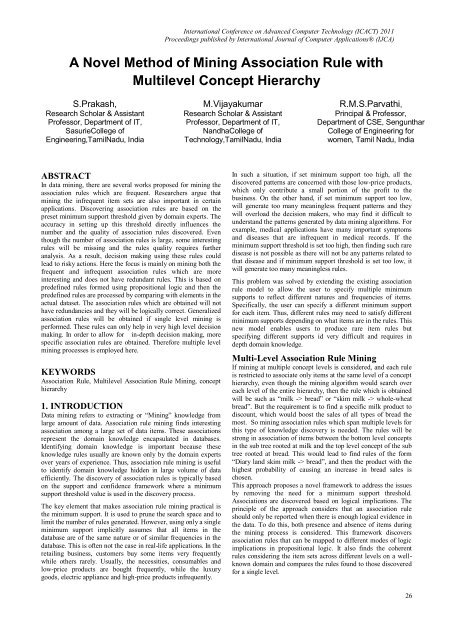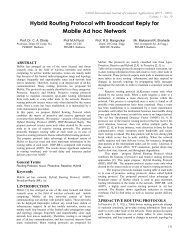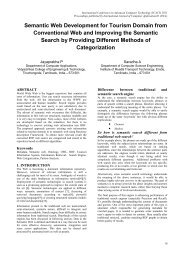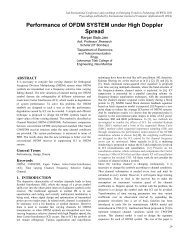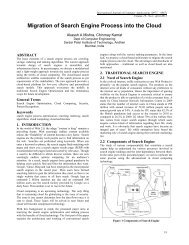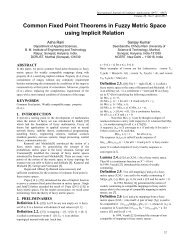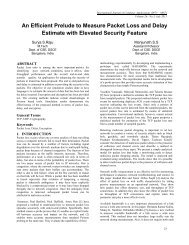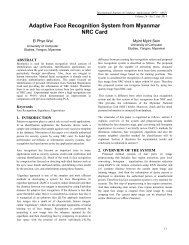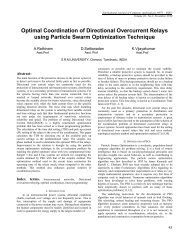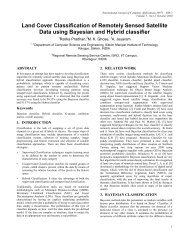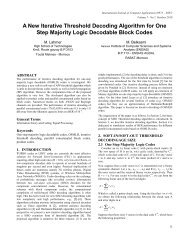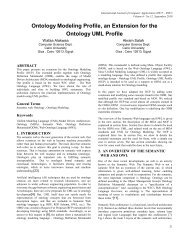A Novel Method of Mining Association Rule with Multilevel Concept ...
A Novel Method of Mining Association Rule with Multilevel Concept ...
A Novel Method of Mining Association Rule with Multilevel Concept ...
You also want an ePaper? Increase the reach of your titles
YUMPU automatically turns print PDFs into web optimized ePapers that Google loves.
International Conference on Advanced Computer Technology (ICACT) 2011<br />
Proceedings published by International Journal <strong>of</strong> Computer Applications® (IJCA)<br />
A <strong>Novel</strong> <strong>Method</strong> <strong>of</strong> <strong>Mining</strong> <strong>Association</strong> <strong>Rule</strong> <strong>with</strong><br />
<strong>Multilevel</strong> <strong>Concept</strong> Hierarchy<br />
S.Prakash,<br />
Research Scholar & Assistant<br />
Pr<strong>of</strong>essor, Department <strong>of</strong> IT,<br />
SasurieCollege <strong>of</strong><br />
Engineering,TamilNadu, India<br />
M.Vijayakumar<br />
Research Scholar & Assistant<br />
Pr<strong>of</strong>essor, Department <strong>of</strong> IT,<br />
NandhaCollege <strong>of</strong><br />
Technology,TamilNadu, India<br />
R.M.S.Parvathi,<br />
Principal & Pr<strong>of</strong>essor,<br />
Department <strong>of</strong> CSE, Sengunthar<br />
College <strong>of</strong> Engineering for<br />
women, Tamil Nadu, India<br />
ABSTRACT<br />
In data mining, there are several works proposed for mining the<br />
association rules which are frequent. Researchers argue that<br />
mining the infrequent item sets are also important in certain<br />
applications. Discovering association rules are based on the<br />
preset minimum support threshold given by domain experts. The<br />
accuracy in setting up this threshold directly influences the<br />
number and the quality <strong>of</strong> association rules discovered. Even<br />
though the number <strong>of</strong> association rules is large, some interesting<br />
rules will be missing and the rules quality requires further<br />
analysis. As a result, decision making using these rules could<br />
lead to risky actions. Here the focus is mainly on mining both the<br />
frequent and infrequent association rules which are more<br />
interesting and does not have redundant rules. This is based on<br />
predefined rules formed using propositional logic and then the<br />
predefined rules are processed by comparing <strong>with</strong> elements in the<br />
actual dataset. The association rules which are obtained will not<br />
have redundancies and they will be logically correct. Generalized<br />
association rules will be obtained if single level mining is<br />
performed. These rules can only help in very high level decision<br />
making. In order to allow for in-depth decision making, more<br />
specific association rules are obtained. Therefore multiple level<br />
mining processes is employed here.<br />
KEYWORDS<br />
<strong>Association</strong> <strong>Rule</strong>, <strong>Multilevel</strong> <strong>Association</strong> <strong>Rule</strong> <strong>Mining</strong>, concept<br />
hierarchy<br />
1. INTRODUCTION<br />
Data mining refers to extracting or “<strong>Mining</strong>” knowledge from<br />
large amount <strong>of</strong> data. <strong>Association</strong> rule mining finds interesting<br />
association among a large set <strong>of</strong> data items. These associations<br />
represent the domain knowledge encapsulated in databases.<br />
Identifying domain knowledge is important because these<br />
knowledge rules usually are known only by the domain experts<br />
over years <strong>of</strong> experience. Thus, association rule mining is useful<br />
to identify domain knowledge hidden in large volume <strong>of</strong> data<br />
efficiently. The discovery <strong>of</strong> association rules is typically based<br />
on the support and confidence framework where a minimum<br />
support threshold value is used in the discovery process.<br />
The key element that makes association rule mining practical is<br />
the minimum support. It is used to prune the search space and to<br />
limit the number <strong>of</strong> rules generated. However, using only a single<br />
minimum support implicitly assumes that all items in the<br />
database are <strong>of</strong> the same nature or <strong>of</strong> similar frequencies in the<br />
database. This is <strong>of</strong>ten not the case in real-life applications. In the<br />
retailing business, customers buy some items very frequently<br />
while others rarely. Usually, the necessities, consumables and<br />
low-price products are bought frequently, while the luxury<br />
goods, electric appliance and high-price products infrequently.<br />
In such a situation, if set minimum support too high, all the<br />
discovered patterns are concerned <strong>with</strong> those low-price products,<br />
which only contribute a small portion <strong>of</strong> the pr<strong>of</strong>it to the<br />
business. On the other hand, if set minimum support too low,<br />
will generate too many meaningless frequent patterns and they<br />
will overload the decision makers, who may find it difficult to<br />
understand the patterns generated by data mining algorithms. For<br />
example, medical applications have many important symptoms<br />
and diseases that are infrequent in medical records. If the<br />
minimum support threshold is set too high, then finding such rare<br />
disease is not possible as there will not be any patterns related to<br />
that disease and if minimum support threshold is set too low, it<br />
will generate too many meaningless rules.<br />
This problem was solved by extending the existing association<br />
rule model to allow the user to specify multiple minimum<br />
supports to reflect different natures and frequencies <strong>of</strong> items.<br />
Specifically, the user can specify a different minimum support<br />
for each item. Thus, different rules may need to satisfy different<br />
minimum supports depending on what items are in the rules. This<br />
new model enables users to produce rare item rules but<br />
specifying different supports id very difficult and requires in<br />
depth domain knowledge.<br />
Multi-Level <strong>Association</strong> <strong>Rule</strong> <strong>Mining</strong><br />
If mining at multiple concept levels is considered, and each rule<br />
is restricted to associate only items at the same level <strong>of</strong> a concept<br />
hierarchy, even though the mining algorithm would search over<br />
each level <strong>of</strong> the entire hierarchy, then the rule which is obtained<br />
will be such as “milk -> bread” or “skim milk -> whole-wheat<br />
bread”. But the requirement is to find a specific milk product to<br />
discount, which would boost the sales <strong>of</strong> all types <strong>of</strong> bread the<br />
most. So mining association rules which span multiple levels for<br />
this type <strong>of</strong> knowledge discovery is needed. The rules will be<br />
strong in association <strong>of</strong> items between the bottom level concepts<br />
in the sub tree rooted at milk and the top level concept <strong>of</strong> the sub<br />
tree rooted at bread. This would lead to find rules <strong>of</strong> the form<br />
“Diary land skim milk -> bread”, and then the product <strong>with</strong> the<br />
highest probability <strong>of</strong> causing an increase in bread sales is<br />
chosen.<br />
This approach proposes a novel framework to address the issues<br />
by removing the need for a minimum support threshold.<br />
<strong>Association</strong>s are discovered based on logical implications. The<br />
principle <strong>of</strong> the approach considers that an association rule<br />
should only be reported when there is enough logical evidence in<br />
the data. To do this, both presence and absence <strong>of</strong> items during<br />
the mining process is considered. This framework discovers<br />
association rules that can be mapped to different modes <strong>of</strong> logic<br />
implications in propositional logic. It also finds the coherent<br />
rules considering the item sets across different levels on a wellknown<br />
domain and compares the rules found to those discovered<br />
for a single level.<br />
26
International Conference on Advanced Computer Technology (ICACT) 2011<br />
Proceedings published by International Journal <strong>of</strong> Computer Applications® (IJCA)<br />
2. LITERATURE SURVEY<br />
Using a minimum support threshold to identify frequent patterns<br />
assumes that an ideal minimum support threshold exists for<br />
frequent patterns, and that a user can identify this threshold<br />
accurately. Assuming that an ideal minimum support exists, it is<br />
unclear how to find this threshold [18]. This is largely due to the<br />
fact that there is no universal standard to define the notion <strong>of</strong><br />
being frequent enough and interesting. In this case one user’s<br />
understanding <strong>of</strong> an ideal strength value may be different from<br />
another user’s.<br />
A data set contains items that appear frequently while other items<br />
rarely occur. For example, in a retail fruit business, fruits are<br />
frequently observed but occasionally bread is also observed.<br />
Some items are rare in nature or infrequently found in a data set.<br />
These items are called rare items [11]. If a single minimum<br />
support threshold is used and is set high, those association rules<br />
involving rare items will not be discovered. Use <strong>of</strong> a single and<br />
lower minimum support threshold, on the other hand, would<br />
result in too many uninteresting association rules. This is called<br />
the rare item problem defined by Mannila. Instead <strong>of</strong><br />
preprocessing the transaction records, using multiple minimum<br />
thresholds called minimum item supports (MISs) . Nonetheless, a<br />
user needs toprovide an MIS threshold for each item which is<br />
difficult. The common aim, however, was to <strong>of</strong>fset heuristics<br />
when setting up a minimum support threshold. In all these<br />
approaches, we see that state-<strong>of</strong>-the-art association rule mining<br />
has drifted from the original idea <strong>of</strong> mining frequent patterns<br />
alone to considering other patterns as well. Using a minimum<br />
support threshold alone cannot identify these patterns<br />
specifically.<br />
Brin [6] shows that association rules discovered using a support<br />
and confidence framework may not be correlated in statistics.<br />
These association rules show item sets co-occurring together,<br />
<strong>with</strong> no implications among them. Scheffer highlights that in<br />
many cases, users who are interested in finding items that cooccur<br />
together are also interested in finding items which are<br />
connected in reality. Having a minimum support threshold does<br />
not guarantee the discovery <strong>of</strong> interesting association rules, as<br />
such rules may need to be further processed and quantified for<br />
interestingness.<br />
The usage <strong>of</strong> leverage and lift are good alternatives in mining<br />
association rules <strong>with</strong>out relying on pruning a minimum support<br />
threshold. The authors in mined arbitrarily top k number <strong>of</strong> rules<br />
using lift, leverage, and confidence <strong>with</strong>out using a preset<br />
minimum support threshold. The use <strong>of</strong> leverage and lift is also<br />
fundamental in designing a new measure <strong>of</strong> interestingness.<br />
Among such work, authors in [13] considered lift as also one <strong>of</strong><br />
the 12 interesting criteria to generate interesting rules called an<br />
informative rule set. Authors in devised a conditional<br />
probability-like measure <strong>of</strong> interestingness based on lift (termed<br />
as dependence) called the Conditional Probability Increment<br />
Ratio (CPIR) and used this to discover required interesting rules<br />
accordingly. Apart from the use <strong>of</strong> lift, leverage, and its derived<br />
measure <strong>of</strong> interestingness, measures <strong>of</strong> interestingness that<br />
consider a deviation from independence have also been used. The<br />
authors in [3] used Pearson’s correlation coefficient to search for<br />
both positive and negative association rules that have a strong<br />
correlation. This search algorithm found the strongest correlated<br />
rules, followed by rules <strong>with</strong> moderate and small strength values.<br />
The generalized framework is used to discover association rules<br />
that have the properties <strong>of</strong> propositional logic, and a specific<br />
framework (Coherent <strong>Rule</strong>s <strong>Mining</strong> Framework) <strong>with</strong> a basic<br />
algorithm to generate coherent rules from a given data set. The<br />
discovery <strong>of</strong> coherent rules is important because through<br />
coherent rules, a complete set <strong>of</strong> interesting association rules that<br />
are also implicational according to propositional logic can be<br />
discovered.<br />
Multi-level association rules are used to find the preferences for<br />
items that are not covered by the single-level association rules<br />
due to the data sparseness. Instead <strong>of</strong> considering single attribute<br />
for the rules multiple attributes are considered for obtaining more<br />
specific rules.<br />
Problem Definition<br />
The coherent rules are identified for the domain and based on the<br />
support value as well as the logical equivalences according to<br />
propositional logic the association rules are filtered out. The rules<br />
obtained include item sets that are frequently and infrequently<br />
observed in a set <strong>of</strong> transaction records for a single level. Here<br />
the generalized framework is obtained. The generalized<br />
framework will not help in-depth decision making as the rules<br />
obtained will be high level. Though the rules are logically<br />
correct, some scenarios occur in which the support is equal for<br />
both the rules that are coherent and here no proper decision can<br />
be made.<br />
3. METHODOLOGY<br />
The steps involved in the development <strong>of</strong> multilevel<br />
propositional logic based knowledge discovery involve the<br />
following phases:<br />
‣ Data Preprocessing<br />
‣ Propositional Logic for Coherent <strong>Rule</strong> Generation<br />
‣ Multi-Level concept hierarchy<br />
‣ Performance measure on generated rules<br />
Data Preprocessing<br />
Data preprocessing is a major step in data mining where all the<br />
unnecessary data in the datasets will be removed. Based on the<br />
nature <strong>of</strong> datasets taken for the experiment the preprocessing<br />
process will take place. If the dataset contains mostly missing<br />
attributes then those should be supplied by taking the previous<br />
observations.<br />
Figure 1Logic Pattern Discovery-useless attributes<br />
Figure 2 Logic Pattern Discovery-duplicate animals list<br />
In this work mainly removing the duplicate records and useless<br />
attributes were performed. Figure 1 shows the logical pattern<br />
discovery for useless attributes. These are done to minimize the<br />
27
International Conference on Advanced Computer Technology (ICACT) 2011<br />
Proceedings published by International Journal <strong>of</strong> Computer Applications® (IJCA)<br />
amount <strong>of</strong> data to be processed and also to remove duplicate<br />
records if any <strong>with</strong> different values which may be misleading.<br />
The useless attribute is nothing but the attribute which contains<br />
unique values. Figure 2 shows logic pattern discovery for<br />
duplicate animal list<br />
3.1 Propositional Logic for Coherent <strong>Rule</strong><br />
Generation<br />
The pseudo implications <strong>of</strong> equivalences are called coherent<br />
rules. Not all pseudo implications <strong>of</strong> equivalences can be created<br />
using item sets X and Y. If one pseudo implication <strong>of</strong><br />
equivalence can be created, then another pseudo implication <strong>of</strong><br />
equivalence also coexists. Two pseudo implications <strong>of</strong><br />
equivalences always exist as a pair because they are created<br />
based on the same conditions. Since they share the same<br />
conditions, two pseudo implications <strong>of</strong> equivalences, coexist<br />
having mapped to two logical equivalences. The result is a<br />
coherent rule that meets the same conditions.<br />
Coherent rules meet the necessary and sufficient conditions and<br />
have the truth table values <strong>of</strong> logical equivalence. The coherent<br />
rule consists <strong>of</strong> a pair <strong>of</strong> pseudo implications <strong>of</strong> equivalences that<br />
have higher support values compared to another two pseudo<br />
implications <strong>of</strong> equivalences. Coherent rules are defined based<br />
on logic. This improves the quality <strong>of</strong> association rules<br />
discovered because there are no missing association rules due to<br />
threshold setting. A user can discover all association rules that<br />
are logically correct <strong>with</strong>out having to know the domain<br />
knowledge. This is fundamental to various application domains.<br />
For example, one can discover the relations in a retail business<br />
<strong>with</strong>out having to study the possible relations among items. Any<br />
association rule that is not captured by coherent rules can be<br />
denied its importance. Figure 3 and 4 shows animal support list<br />
and rule list respectively<br />
patterns and strong association rules at the top-most concept<br />
level. With this user can find a set <strong>of</strong> pair-wised frequent items<br />
and a set <strong>of</strong> association rules at each level. The process repeats at<br />
even lower concept levels until no frequent patterns can be<br />
found. During multilevel association rule mining, the taxonomy<br />
information for each (grouped) item is encoded as a sequence <strong>of</strong><br />
digits in the transaction table. Repeated items (i.e., items <strong>with</strong> the<br />
same encoding) at any level will be treated as one item in one<br />
transaction.<br />
In the proposed concept hierarchy model, items may have<br />
different propositional logic and taxonomic relationships to<br />
discover the large item sets. The propositional logic for an item<br />
set is set as the combinatorial sub logic supports <strong>of</strong> the items<br />
contained in the item set, while the propositional logic for an<br />
item at a higher taxonomic concept is set as the minimum sub<br />
logics <strong>of</strong> the items belonging to it. Encoding scheme represents<br />
nodes in the predefined taxonomies for mining multilevel rules.<br />
Figure 5 shows the multiple attribute rule list.<br />
Nodes are encoded <strong>with</strong> respect to their positions in the hierarchy<br />
using sequences <strong>of</strong> numbers and the symbol. It then filters out<br />
unpromising item sets in two phases. In the first phase, an item<br />
group is removed if its occurring count is less than the<br />
propositional logic. In the second phase, the count <strong>of</strong> a<br />
propositional logic rules is checked to determine whether it is<br />
large. The proposed algorithm then finds all the large item sets<br />
for the given transactions by comparing the count <strong>of</strong> each item<br />
set <strong>with</strong> its combinatorial logic.<br />
3.3. Performance Measure On Generated<br />
<strong>Rule</strong>s<br />
The employed multilevel concept hierarchy based association<br />
rule mining using propositional logic is experimented <strong>with</strong><br />
synthetic data to evaluate the association rule and coherent rules<br />
<strong>with</strong>out having the domain knowledge. The results are also<br />
compared <strong>with</strong> logic based pattern discovery model <strong>with</strong> single<br />
level association rule mining model in terms <strong>of</strong> number <strong>of</strong> strong<br />
rules and weak rules generated. Effects <strong>of</strong> non sensitive rules are<br />
derived in both the existing and proposed schemes to show the<br />
efficiency <strong>of</strong> novel association rule mining process.<br />
Figure 3 Support List<br />
Figure 5 Multiple Attribute <strong>Rule</strong> List<br />
Figure 4 <strong>Rule</strong> list<br />
3.2 Multi-Level <strong>Concept</strong> Hierarchy<br />
In multilevel association rules mining, different propositional<br />
logic is used at different concept levels. Discover frequent<br />
The models works well <strong>with</strong> problems involving uncertainty in<br />
data relationships, which are represented by multilevel concepts<br />
for propositional logic rule derivation. The proposed mining<br />
algorithm can thus generate large item sets level by level and<br />
then derive concept multilevel association rules from transaction<br />
dataset. The results shown in the example implies that the<br />
proposed algorithm can derive the multiple-level association<br />
rules under different propositional logic in a simple and effective<br />
way.<br />
28
International Conference on Advanced Computer Technology (ICACT) 2011<br />
Proceedings published by International Journal <strong>of</strong> Computer Applications® (IJCA)<br />
4. SYSTEM IMPLEMENTATION<br />
The proposed system is very easy to implement. In general<br />
implementation is used to mean the process <strong>of</strong> converting a new<br />
or revised system design into an operational one. The<br />
implementation can be preceded <strong>with</strong> UCI data repository<br />
through Swing in java which supports numerous look and feels,<br />
including the ability to create own look and feel. The ability to<br />
create a custom look and feel is made easier. The main<br />
characteristics <strong>of</strong> the Swing toolkit are platform independent,<br />
customizable, extensible, configurable and lightweight.<br />
Comparison between single level association rules and multilevel<br />
association rule are shown in figure 6<br />
The implementation phase is less creative than system design. It<br />
is primarily concerned <strong>with</strong> user training, and file conversion.<br />
The system may be requiring extensive user training. The initial<br />
parameters <strong>of</strong> the management information system should be<br />
modifies as a result <strong>of</strong> a programming. The system developed is<br />
completely menu driven. Further a simple operating procedure is<br />
provided so that the user can understand the different functions<br />
clearly and quickly.<br />
Figure 6 single level association rules Vs <strong>Multilevel</strong><br />
association rule in terms <strong>of</strong> rule generation<br />
5. CONCLUSION<br />
The proposed multilevel association rule mining include item<br />
sets that are frequently and infrequently observed in a set <strong>of</strong><br />
transaction records. In addition to a complete set <strong>of</strong> rules being<br />
considered, these association rules can also be reasoned as<br />
logical implications because they inherit propositional logic<br />
properties. These association rules reduce the risks associated<br />
<strong>with</strong> using an incomplete set <strong>of</strong> association rules for decision<br />
making. The multilevel coherent rules mining framework is<br />
appreciated for its ability to discover rules that are both<br />
implicational and complete according to propositional logic from<br />
a given data set at various conceptual levels.<br />
This work can be enhanced by taking an unclassified dataset and<br />
perform classification before performing the experiment. But this<br />
classification should be appropriate in such a way that the rules<br />
obtained in the result should also be logically true when they are<br />
compared <strong>with</strong> the original dataset before classification.<br />
6. REFERENCES<br />
[1] Agrawal R., Imielinski T. and Swami A. (1993) “<strong>Mining</strong><br />
<strong>Association</strong> <strong>Rule</strong>s between Sets <strong>of</strong> Items in Large<br />
Databases” SIGMOD Record, vol. 22, pp. 207-216.<br />
[2] Alex TzeHiangSim, Maria Indrawan, SamarZutshi and<br />
BalaSrinivasan(2010) “Logic Based Pattern Discovery”<br />
IEEE Transactions on Knowledge and Data Engineering,<br />
VOL. 22, NO. 6, pp.798-811.<br />
[3] Antonie M.-L. and Zaýane O.R. (2004) “<strong>Mining</strong> Positive<br />
and Negative <strong>Association</strong> <strong>Rule</strong>s: An Approach for Confined<br />
<strong>Rule</strong>s” Proc. European Conf. Principles and Practice <strong>of</strong><br />
Knowledge Discovery in Databases (PKDD ’04), pp. 27-38.<br />
[4] Bing Liu, Minqing Hu, and Wynne Hsu (2000) “Multi-<br />
Level Organization and Summarization <strong>of</strong> the Discovered<br />
<strong>Rule</strong>s” Proc. ACM SIGKDD, Aug 20-23.<br />
[5] Blanchard J., Guillet F., Briand H. and Gras R. (2005)<br />
“Assessing <strong>Rule</strong> Interestingness <strong>with</strong> a Probabilistic<br />
Measure <strong>of</strong> Deviation from Equilibrium” Proc. 11th Int’l<br />
Symp. Applied Stochastic Models and Data Analysis<br />
(ASMDA ’05), pp. 191-200.<br />
[6] Brin S., Motwani R. and Silverstein C. (1997) “Beyond<br />
Market Baskets: Generalizing <strong>Association</strong> <strong>Rule</strong>s to<br />
Correlations” Proc. 1997 ACM SIGMOD, pp. 265-276.<br />
[7] Cao Longbing (2008) “Introduction to Domain Driven Data<br />
<strong>Mining</strong>,” Data <strong>Mining</strong> for Business Applications, Springer,<br />
pp. 3-10.<br />
[8] Choonho Kim and Juntae Kim (2003) ”A Recommendation<br />
Algorithm Using Multi-Level <strong>Association</strong> <strong>Rule</strong>s” Proc.<br />
IEEE/WIC Int’l Conf. on Web Intelligence page. 52.<br />
[9] Hellerstein J.L., Ma S., Perng C (2002) ”Discovering<br />
actionable patterns in event data” IBM Systems Journal, Vol<br />
41, NO 3.<br />
[10] KanimozhiSelvi C.S. and Tamilarasi A. (2009) ”An<br />
Automated <strong>Association</strong> <strong>Rule</strong> <strong>Mining</strong> Technique With<br />
Cumulative Support Thresholds”Int. J. Open Problems in<br />
Compt. Math, Vol. 2, No. 3.<br />
[11] Koh Y.S., Rountree N. and O’Keefe R.A (2006) “Finding<br />
Non-Coincidental Sporadic <strong>Rule</strong>s Using Apriori-Inverse”<br />
Int’l J. Data Warehousing and <strong>Mining</strong>, vol. 2, pp. 38-54.<br />
[12] Laszlo Szathmary, Amedeo Napoli and PetkoValtchev<br />
(2007) “Towards Rare Itemset <strong>Mining</strong>” Proc. <strong>of</strong> the 19th<br />
IEEE ICTAI, Vol. 1,pp. 305-312.<br />
[13] Li J. and Zhang Y. (2003) “Direct Interesting <strong>Rule</strong><br />
Generation” Proc. Third IEEE Int’l Conf. Data <strong>Mining</strong>, pp.<br />
155-162.<br />
29


